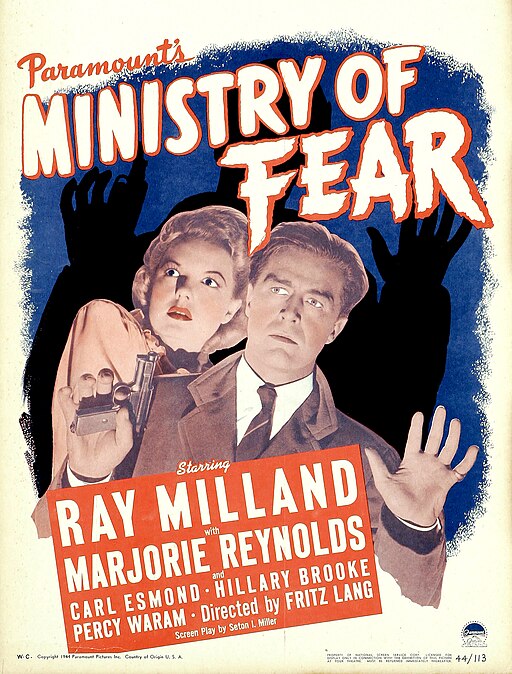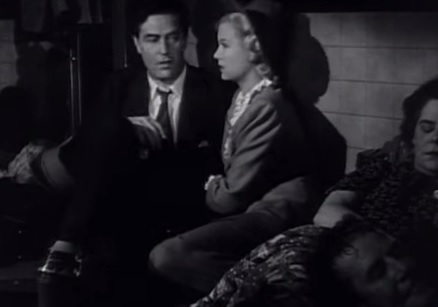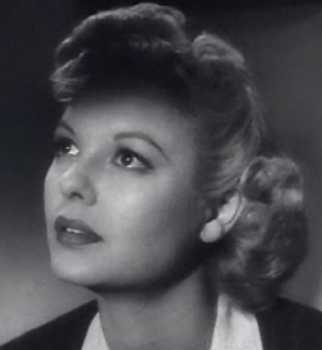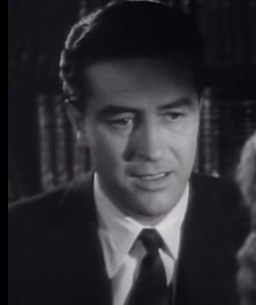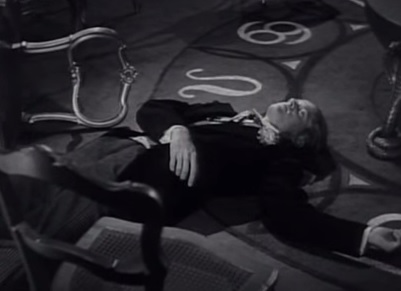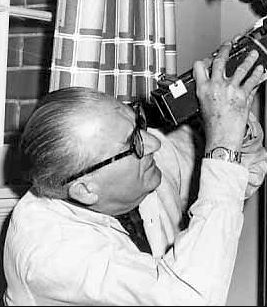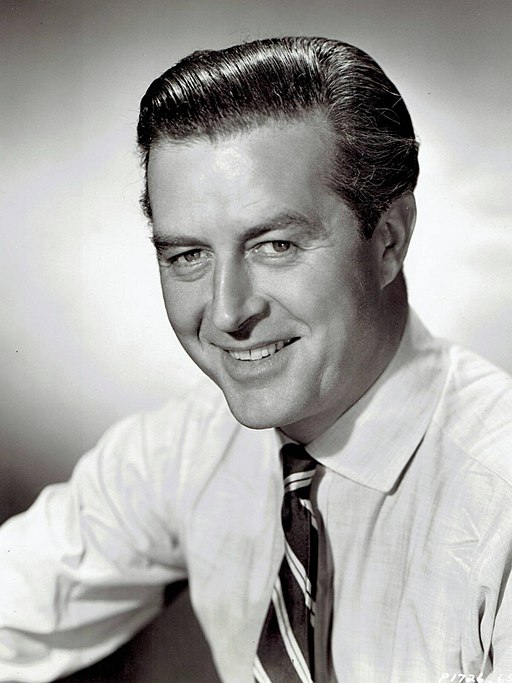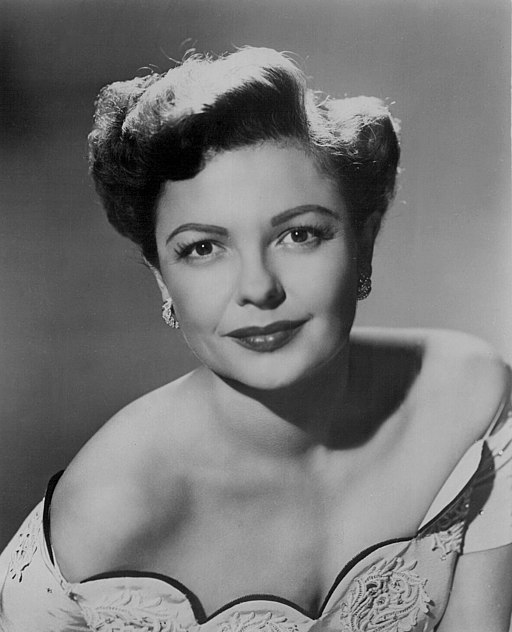Ministry of Fear - 1944
back| Released by | Paramount Pictures |
| Director | Fritz Lang |
| Producer | Seton I. Miller |
| Script | Based on the novel |
| Cinematography | Henry Sharp |
| Music by | Victor Young |
| Running time | 86 minutes |
| Film budget | Unknown |
| Box office sales | Unknown |
| Main cast | Ray Milland - Marjorie Reynolds - Carl Esmond - Hillary Brooke - Percy Waram |
Ministry of Fear
A Gripping Wartime Thriller
"Ministry of Fear" is a film noir thriller set during World War II, following the story of Stephen Neale, who becomes entangled in espionage and intrigue after being released from a mental asylum.
The film is notable for its atmospheric direction by Fritz Lang and the tense, suspenseful plot adapted from Graham Greene's novel.
Related
Ministry of Fear – 1944
Summary and Analysis
"Ministry of Fear" is set in England during World War II. The film opens with Stephen Neale (Ray Milland) being released from a mental asylum after two years of confinement. He was institutionalized after mercy-killing his terminally ill wife. Now free, he is eager to start a new life. On his way to London, he visits a village fair where he wins a cake in a seemingly innocent game of guessing its weight. This event spirals into a series of dangerous and mysterious encounters.
Unbeknownst to Neale, the cake contains a secret microfilm intended for a group of Nazi spies. The leader of this spy ring is a tailor named Willi Hilfe (Carl Esmond), who, along with his sister Carla (Marjorie Reynolds), operates under the guise of running a refugee organization. When Neale discovers the cake's true contents, he becomes the target of both the spies and the British authorities, who suspect him of espionage.
Neale meets Carla Hilfe and becomes entangled in a web of deception, murder, and espionage. Together, they attempt to unravel the mystery behind the cake and the sinister conspiracy it represents. Throughout the film, Neale faces numerous threats and close calls, including an assassination attempt disguised as a séance and a perilous encounter at a tailor shop that serves as a front for the spy network.
As Neale and Carla delve deeper into the conspiracy, they uncover a Nazi plot to sabotage the British war effort. With Carla's help, Neale manages to outwit the spies and expose their plans. In a climactic showdown, the ringleader of the espionage operation is revealed and brought to justice.
The film concludes with Neale cleared of all suspicion and finally able to move on with his life. He and Carla, having survived their ordeal, look forward to a future together, free from the shadows of war and espionage.
Analysis:
"Ministry of Fear" is a quintessential film noir that expertly blends elements of suspense, mystery, and espionage. Directed by Fritz Lang, the film is a dark, atmospheric thriller that reflects the anxieties and uncertainties of its wartime setting.
Themes:
- Paranoia and Trust: The film explores the pervasive paranoia of the era, where trust is a rare commodity. Neale's journey from a mental asylum to the center of an espionage ring symbolizes the fragile line between sanity and madness, trust and betrayal. The characters' motivations are often ambiguous, keeping the audience guessing about who can be trusted.
- Identity and Deception: Lang uses the theme of mistaken identity and deception to drive the plot. Neale's identity is constantly questioned, and he must navigate a world where appearances are deceiving. The spies' use of innocent fronts, such as the village fair and the tailor shop, underscores the idea that danger can lurk behind the most benign facades.
- Isolation and Redemption: Neale's isolation, both physical and emotional, is a central theme. His release from the asylum marks the beginning of his quest for redemption. Throughout the film, he struggles to prove his innocence and uncover the truth, ultimately finding redemption through his bravery and determination.
Cinematography: Henry Sharp's cinematography enhances the film's noir atmosphere with stark contrasts, deep shadows, and claustrophobic framing. The use of low-key lighting and oblique camera angles creates a sense of unease and tension, reflecting Neale's disoriented mental state and the pervasive threat of the unseen enemy.
Direction: Fritz Lang's direction is masterful, imbuing the film with a sense of urgency and suspense. Lang, known for his meticulous attention to detail, constructs a narrative that is both tightly plotted and rich in psychological complexity. His use of visual symbolism, such as the recurring motif of the cake, adds layers of meaning to the story.
Performances: Ray Milland delivers a compelling performance as Stephen Neale, capturing the character's vulnerability and determination. Marjorie Reynolds provides a strong supporting role as Carla Hilfe, balancing strength and sensitivity. The supporting cast, including Carl Esmond and Dan Duryea, contribute to the film's tense atmosphere with their portrayals of sinister and duplicitous characters.
Music: Victor Young's score complements the film's mood, using orchestral arrangements to heighten suspense and underscore emotional moments. The music is both haunting and evocative, enhancing the film's overall impact.
Official Trailer of Ministry of Fear:
Full Cast of the Movie:
- Ray Milland as Stephen Neale
- Marjorie Reynolds as Carla Hilfe
- Carl Esmond as Willi Hilfe
- Hillary Brooke as Mrs. Bellane #2
- Percy Waram as Inspector Prentice
- Dan Duryea as Mr. Travers
- Alan Napier as Dr. Forrester
- Erskine Sanford as Mr. Newland
- Aminta Dyne as Mrs. Bellane #1
- Mary Field as Mrs. Rennit
- Marjorie Wood as Martha
- Helmut Dantine as Austrian Refugee (uncredited)
- Billy Bevan as Willi Hilfe’s Landlord (uncredited)
- Byron Foulger as Manny (uncredited)
Masterful Performance of Ray Milland:
Ray Milland's performance in "Ministry of Fear" (1944) is a masterclass in capturing the nuances of a character caught in a web of intrigue and paranoia. As Stephen Neale, Milland brings a compelling mix of vulnerability, determination, and underlying tension to the role.
Vulnerability and Trauma: Milland convincingly portrays Neale's vulnerability, a man recently released from a mental asylum after a traumatic experience. His initial scenes reflect a palpable sense of fragility and disorientation, setting the stage for his character's journey. Milland's expressions and body language convey a haunted quality, suggesting a man still grappling with the ghosts of his past. This vulnerability makes Neale a sympathetic figure, drawing the audience into his plight.
Determination and Resilience: As the plot unfolds, Milland deftly transitions from a fragile state to one of determination. His portrayal of Neale's growing resolve to uncover the truth behind the mysterious cake and the espionage plot is both believable and inspiring. Milland imbues his character with a quiet but steely resilience, showing how Neale, despite his initial hesitation, rises to the challenges he faces. This evolution is central to the film's narrative, and Milland navigates it with subtlety and skill.
Tension and Paranoia: Milland excels in depicting the pervasive tension and paranoia that define the film. His interactions with other characters are laced with suspicion and guardedness, reflecting the atmosphere of wartime espionage. Milland's ability to maintain a sense of unease and suspicion in his performance keeps the audience on edge. His eyes, often wide with apprehension, and his cautious movements underscore the constant threat Neale feels.
Emotional Depth: Milland's performance is not just about the external threats Neale faces but also about the internal struggle. His moments of introspection, where he grapples with his past actions and current fears, add emotional depth to the character. Milland's ability to convey this inner turmoil without resorting to melodrama is a testament to his acting prowess. His nuanced performance ensures that Neale remains a multi-dimensional character throughout the film.
Chemistry with Co-stars: Milland's interactions with his co-stars, particularly Marjorie Reynolds (Carla Hilfe), are pivotal to the film's dynamic. His chemistry with Reynolds is natural and engaging, adding a layer of personal connection amidst the broader espionage narrative. Their partnership, built on mutual trust and shared danger, is convincingly portrayed, with Milland balancing protectiveness and reliance in his scenes with Reynolds.
Climactic Scenes: In the film's climactic moments, Milland's performance reaches its peak. His portrayal of Neale's confrontation with the villains and his final moments of triumph and relief are powerful and cathartic. Milland effectively captures the shift from desperation to resolution, ensuring the audience remains invested in Neale's fate until the very end.
Overall Impact: Ray Milland's performance in "Ministry of Fear" is a cornerstone of the film's success. He brings a complex character to life with authenticity and depth, navigating the film's twists and turns with ease. Milland's ability to portray a man on the edge, yet driven by a core of resilience and integrity, makes Stephen Neale a memorable and compelling protagonist. His performance not only enhances the film's narrative but also anchors its emotional and psychological impact, solidifying "Ministry of Fear" as a standout piece in the film noir genre.
Notable Quotes from the Movie:
- Stephen Neale: "There is a war on. And in a war, everybody, no matter who they are, gets a bullet."
- Carla Hilfe: "You shouldn't have come here. You're in great danger. We both are."
- Stephen Neale: "I've just come out of a lunatic asylum. I might still be mad. How do I know you're real?"
- Mrs. Bellane #2: "Trust no one, Mr. Neale. Trust no one."
- Inspector Prentice: "This is not just a simple murder case. There's more at stake here than you realize."
- Stephen Neale: "I didn't ask for any of this. I just wanted a fresh start."
- Willi Hilfe: "Sometimes, the most innocent things are the most dangerous."
- Stephen Neale: "I guess in the end, the only person you can trust is yourself."
No Awards for “Ministry of Fear”:
"Ministry of Fear" (1944) did not receive any major awards or nominations. Despite being directed by the renowned Fritz Lang and featuring strong performances by its cast, the film did not garner significant recognition in terms of awards during its release period.
The film has since gained recognition and appreciation within the film noir genre and among classic film enthusiasts, but at the time of its release, it did not achieve notable accolades or nominations in major award circuits like the Academy Awards or Golden Globe Awards.

